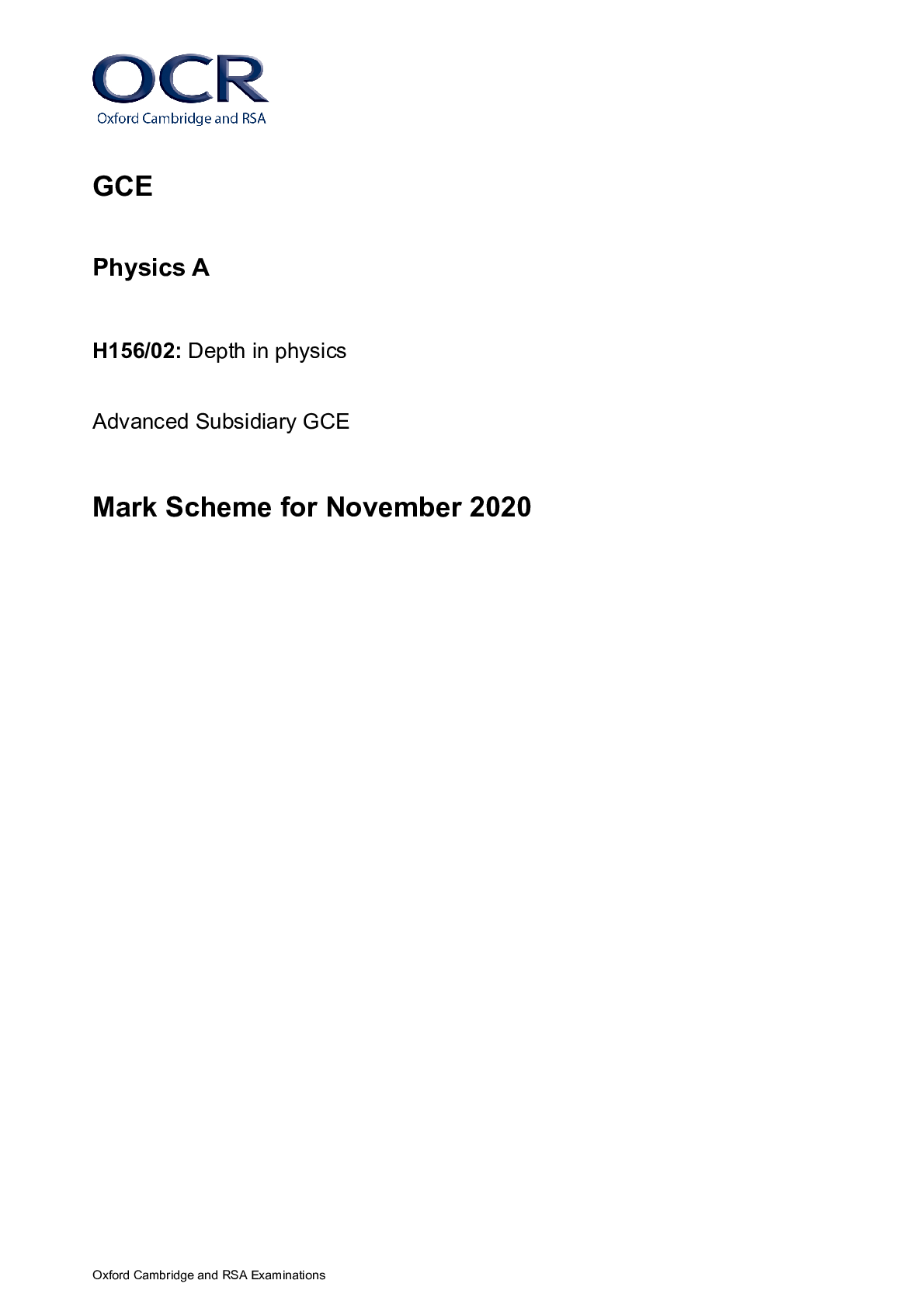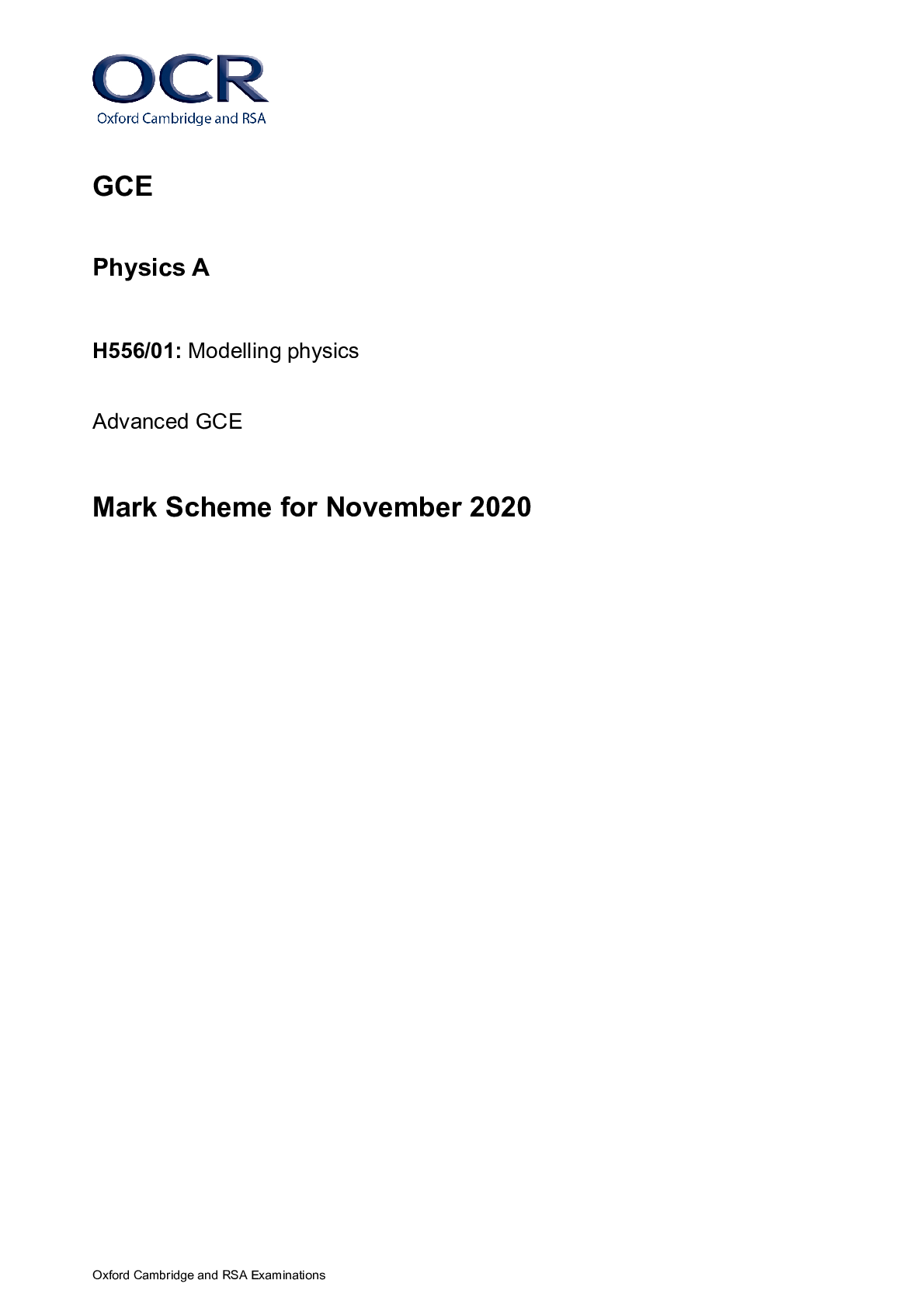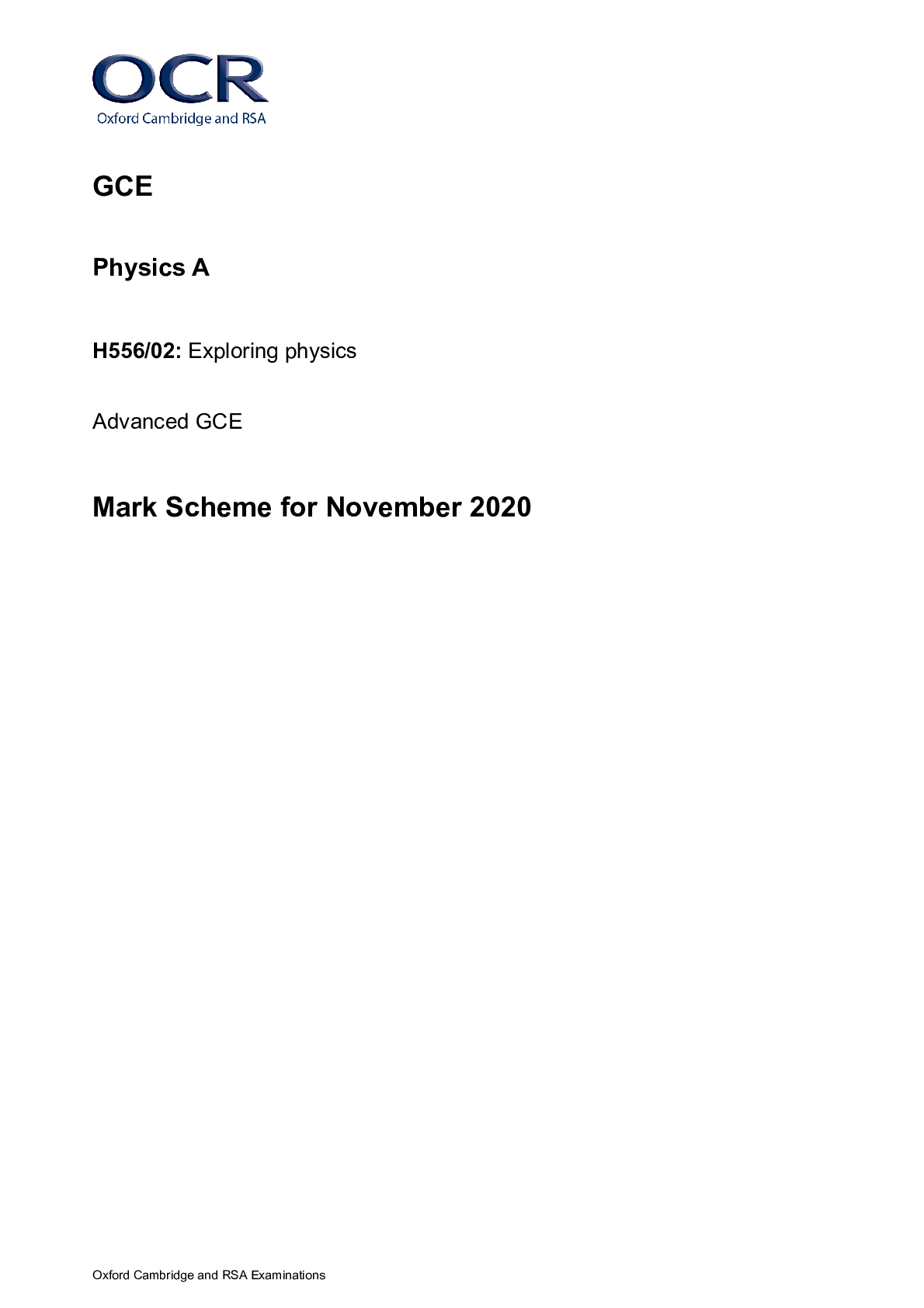Mathematics > AS Mark Scheme > GCE Further Mathematics B (MEI) Y433/01: Modelling with algorithms Advanced GCE Mark Scheme for Autu (All)
GCE Further Mathematics B (MEI) Y433/01: Modelling with algorithms Advanced GCE Mark Scheme for Autumn 2021
Document Content and Description Below
Oxford Cambridge and RSA Examinations GCE Further Mathematics B (MEI) Y433/01: Modelling with algorithms Advanced GCE Mark Scheme for Autumn 2021Oxford Cambridge and RSA Examinations OCR (Oxford... Cambridge and RSA) is a leading UK awarding body, providing a wide range of qualifications to meet the needs of candidates of all ages and abilities. OCR qualifications include AS/A Levels, Diplomas, GCSEs, Cambridge Nationals, Cambridge Technicals, Functional Skills, Key Skills, Entry Level qualifications, NVQs and vocational qualifications in areas such as IT, business, languages, teaching/training, administration and secretarial skills. It is also responsible for developing new specifications to meet national requirements and the needs of students and teachers. OCR is a not-for-profit organisation; any surplus made is invested back into the establishment to help towards the development of qualifications and support, which keep pace with the changing needs of today’s society. This mark scheme is published as an aid to teachers and students, to indicate the requirements of the examination. It shows the basis on which marks were awarded by examiners. It does not indicate the details of the discussions which took place at an examiners’ meeting before marking commenced. All examiners are instructed that alternative correct answers and unexpected approaches in candidates’ scripts must be given marks that fairly reflect the relevant knowledge and skills demonstrated. Mark schemes should be read in conjunction with the published question papers and the report on the examination. © OCR 2021Y433/01 Mark Scheme October 2021 Annotations and abbreviations Annotation in scoris Meaning and BOD Benefit of doubt FT Follow through ISW Ignore subsequent working M0, M1 Method mark awarded0,1 A0, A1 Accuracy mark awarded0, 1 B0, B1 Independent mark awarded 0,1 E Explanation mark 1 SC Special case ^ Omission sign MR Misread BP Blank page Highlighting Other abbreviations in mark scheme Meaning E1 Mark for explaininga resultor establishing a givenresult dep* Mark dependent on a previous mark, indicated by *.The * may be omitted if onlyprevious M mark. cao Correct answer only oe Or equivalent rot Rounded or truncated soi Seen or implied www Without wrong working AG Answer given awrt Anything which roundsto BC By Calculator DR This indicates that the instruction Inthis question you must show detailed reasoning appears in the question.Y433/01 Mark Scheme October 2021 Question Answer Marks AOs Guidance 1 (a) Bin 1: 5 16 12 10 M1 1.1 First six values placed correctly (the values Bin 2: 15 21 5 3 in bold) – so the 10 in the correct bin Bin 3: 17 6 13 5 Bin 4: 24 A1 1.1 cao [2] 1 (b) e.g. M1 1.1 At least two full bins (= 45) Bin 1: 24 21 Bin 2: Bin 3: Bin 4: 16 17 12 15 6 13 10 5 55 3 A1 1.1 cao (three full bins with 17 units in the nonfull bin) [2] 22 (a) (b) M1 A1 A1 3.1b 3.1a 1.1 Activity on arc, single start vertex Precedences correct for A, B, C, D, G, H Directions may be implied Durations not necessary Single finish Precedences correct for E, F, I, J, K Directions may be implied Durations not necessary All three dummies correct and no extras All arcs directed [3] M1 ft M1 ft A1 [3] 3.1b 1.1 1.1 Network must have at least one burst and at least one merge, other than start and finish Forward pass, increasing, allow 1 blank Backward pass, decreasing, allow 1 blank Forward pass and backward pass correctY433/01 Mark Scheme October 2021 Question Answer Marks AOs Guidance 2 (c) Minimum completion time is 31 (hours) B1ft [1] 2.2a Follow through their network 2 (d) Interfering float for H is (22 – 8) – (21 – 8) = 1 (hour) B1ft [1] 3.4 Follow through using their early and late event times at the beginning and end of H 2 (e) Total float for E is 21 – 11 – 6 (= 4) and Total float for G is 21 – 8 – x (= 13 – x) 13 – x < 2×4 or 13 – x ≤ 8 5 ≤ x <13 M1 * M1dep* A1 [3] 1.1 2.1 2.2a Correct calculations of the total float for their E and G Using the given information to set up an inequality for x cao 3 (a) (i) The sum of the vertex orders equals the number of arc endings Each arc has two ends so the sumber of arc endings is twice the number of arcs So the sum of the vertex orders is twice the number of arcs, which is even B1 2.1 States or uses the result that the sum of the order of the vertices is equal to twice the number of arcs Alternative method Let a graph have e edges and n nodes (vertices), let di represent n the order of the ith node so ∑di = 2e , which is even i=1 B1 [1] 3 (a) (ii) The sum of the orders of all the even vertices will be an even number so the sum of the order of the odd vertices must be an even number too Hence a graph must have an even number of vertices of odd order So no graph has an odd number of odd vertices B1 2.2a Correctly explains why a graph cannot have an odd number of vertices with odd order (or must have an even number of vertices with odd order) Must refer to even vertices as well as odd [1]Y433/01 Mark Scheme October 2021 Question Answer Marks AOs Guidance 3 (b) Shortest path from A to F is ACDHIF M1 A1 A1 A1 B1 [5] 1.2 1.1a 1.1a 1.1 1.1 Correct working values at D Working values Labels Order of labelling Allow one slip 3 (c) STEP 1 M1 * M1 dep* M1 dep* A1 [4] 1.1 1.1 1.1 1.1 Any two rows correct Any three rows correct Any four rows correct All correct Possible pairings of odd nodes Corresponding shortest path Weight of shortest path AE ACBE 37 AG ACBG 32 AI ACDHI 48 EG EBG 25 EI EBGI 43 GI GI 18Y433/01 Mark Scheme October 2021 Question Answer Marks AOs Guidance 3 (d) STEP 2 AE and GI STEP 3 353 + 37 + 18 = 408 B1 B1 [2] 3.4 1.1 Both chosen, allow ACBE and GI cao 4 (a) (i) Cut α = 22 + 43 + 71 + 47 = 183 B1 1.1 cao, need not show working [1] 4 (a) (ii) Cut β = 82 + 33 + 43 + 71 + 25 + 39 = 293 B1 1.1 cao, need not show working [1] 4 (b) The maximum possible flow is (at most) 183 (litres per minute) B1 ft [1] 1.1 min{their (a)(i), their (a)(ii)} 4 (c) The only arc leading into C is SC and the only arcs out of C are CB and CF and hence SC – CB – CF = 0 B1 [1] 2.4 Flow in = flow out at C and stating that these are the only arcs that flow into C and out of C 4 (d) Maximise DT + ET + GT SB + AB + CB – BD – BE – BG – BF = 0 BE + DE − EG − ET = 0 DT ≤82,ET ≤ 24,GT ≤ 67 B1 B1 B1 [3] 3.1b 3.3 3.3 Maximise and DT + ET + GT Flow in = flow out at B and at E represented using these equations Capacities for arcs into T represented using these inequalitiesY433/01 Mark Scheme October 2021 Question Answer Marks AOs Guidance 4 (e) M1 A1 [2] 2.1 2.2a Flow = 152. Consistent flow pattern (flow in = flow out at each node) – flowthrough every arc apart from DE and EG Condone incorrect or missingflowthrough one arc for the M mark A correct flow (flow ≤ capacity for each arc) 4 (f) The capacity of thecut which partitions the vertices into the sets {S, A, B, C, E, F, G}, {D, T} is 22 + 39 + 24 + 67 = 152 [∴ minimum cut is ≤ 152 ] By the maximum flow-minimum cut theorem the maximum flow is equal to the minimum cut and so therefore the maximum flow through the system is 152 litres per minute M1 A1 [2] 3.1b 2.1 {S, A, B, C, E, F, G}, {D, T} described in any way (but not implied) Max flow = min cut (o.e) 4 (g) From the source there is only one non-saturated arc SA and into the sink there is only one non-saturated arc DT. Therefore the flow can be increased by the least of 82 – 61 = 21 and 62 – 34 = 28 giving a maximum flow of 152 + 21 = 173 (litres per minute) The corresponding value of x is 21 + 22 = 43 B1 B1 [2] 3.4 2.2a 173 43Y433/01 Mark Scheme October 2021 Question Answer Marks AOs Guidance 5 (a) x + y + z = 50 ⇒ x + y + z ≤ 50 and x + y + z ≥ 50 x + y + z + s1 = 50 and x + y + z − s2 + a1 = 50 x ≤ 25 ⇒ x + s3 = 25 − y + 3z ≤ 0 ⇒ − y + 3z + s4 = 0 x + 4 y +12z ≤ 210 ⇒ x + 4 y+12z + s5 = 210 P = 2x + 5y + 20z ⇒ P − 2x − 5y − 20z = 0 Q = a1 so Q + x + y + z − s2 = 50 M1 A1 M1 A1 B1 M1 A1 M1 A1 [9] 3.1a 1.1 1.1 3.1b 3.1a 2.1 2.2a 3.3 1.1 Dealing with equality constraint as two inequalities or implied from two correct equations (with slack, surplus and artificial variables) Or SC B1 for one correct equation (if previous mark not earned) Adding a slack variable appropriately to any of these three All three correct in this form Allow x – y – z < 0 o.e. for x < 25 Or equivalent with surplus and artificial variables in one of these equations cao Attempt to substitute expression for a1 (artificial variable for equality constraint) cao Any three rows correct cao (rows in any order, with slack variables used appropriately) Q P x y z s1 s2 s3 s4 s5 a1 RHS 1 0 1 1 1 0 −1 0 0 0 0 50 0 1 −2 −5 −20 0 0 0 0 0 0 0 0 0 1 1 1 1 0 0 0 0 0 50 0 0 1 1 1 0 −1 0 0 0 1 50 0 0 1 0 0 0 0 1 0 0 0 25 0 0 0 −1 3 0 0 0 1 0 0 0 0 0 1 4 12 0 0 0 0 1 0 210Y433/01 Mark Scheme October 2021 Question Answer Marks AOs Guidance 5 (b) x ≤ 25 , −y + 3(50 − x − y) ≤ 0 and x + 4y +12(50 − x − y) ≤ 210 x ≤ 25,3x + 4 y ≥ 150 and 11x + 8 y ≥ 390 M1 * M1 dep* A1 M1 A1 [5] 3.1a 1.1 1.1 1.1 1.1 Substitute x + y + z = 50 to form expressions in x and y only Any two of these correct All correct, need not be simplified Two of their lines drawn correctly (may need to check constraints in (a) as well) All three lines correct with correct feasible region, from shading or labelledY433/01 Mark Scheme October 2021 Question Answer Marks AOs Guidance 5 (c) P = 2x + 5y + 20(50 − x − y) ⇒ P = (1000)−18x −15y So maximising the negative expression −3(6x + 5y) is equivalent to minimising the equivalent positive expression 3(6x + 5y) and the optimal values of x and y can be found by just considering 6x + 5 y M1 A1 [2] 3.4 2.4 Substitute x + y + z = 50 into P and simplify 5 (d) (i) Leo should answer 18 algebra questions, 24 trigonometry questions and 8 calculus questions B1 [1] 3.2a In context 5 (d) (ii) Leo will score 316 points B1 [1] 1.1 5 (e) There is no guarantee that Leo will get the answers to the questions correct B1 [1] 3.5b oe correct reasonOCR (Oxford Cambridge and RSA Examinations) The Triangle Building Shaftesbury Road Cambridge CB2 8EA OCR Customer Contact Centre [Show More]
Last updated: 1 year ago
Preview 1 out of 12 pages
Instant download
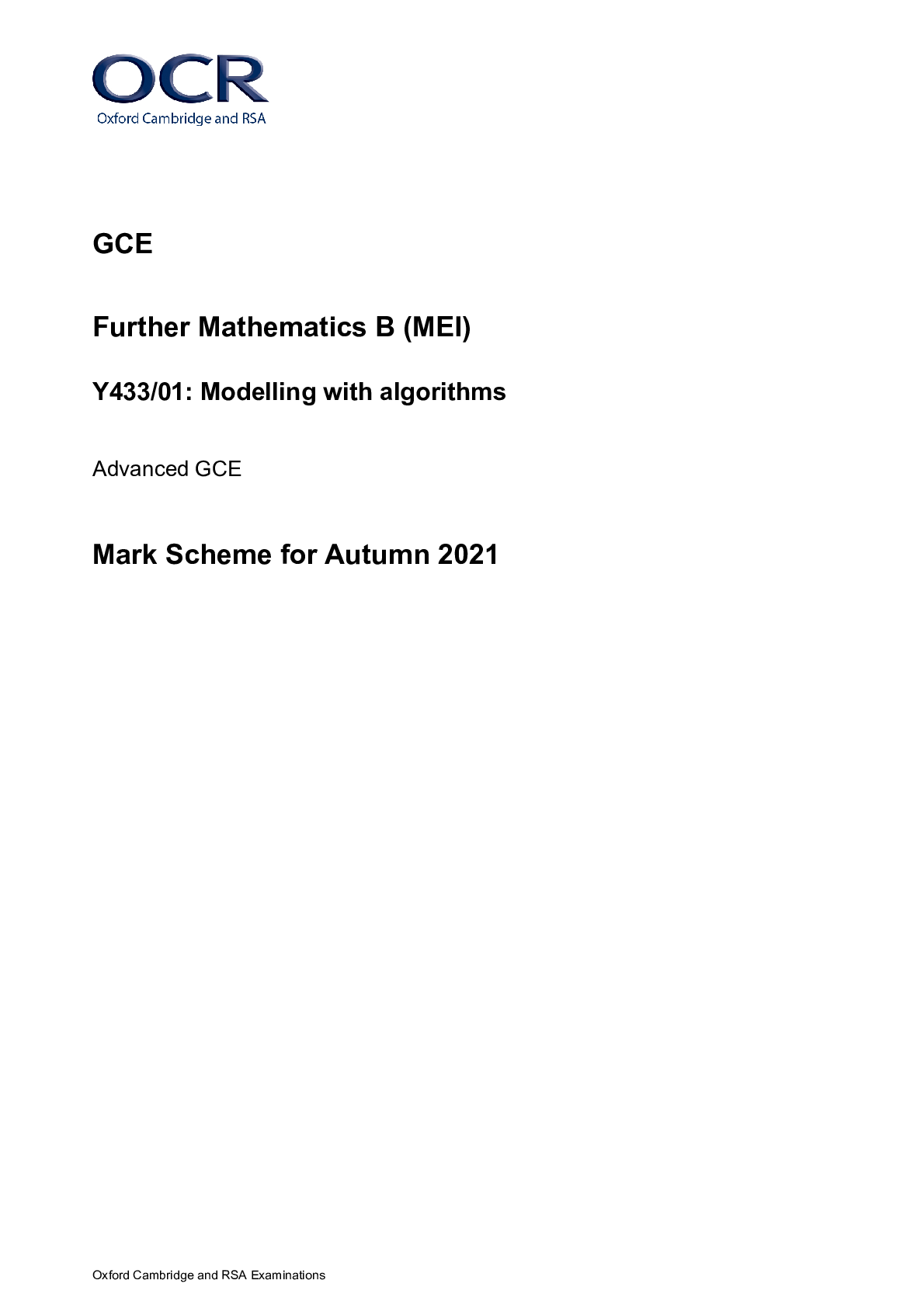
Buy this document to get the full access instantly
Instant Download Access after purchase
Add to cartInstant download
Reviews( 0 )
Document information
Connected school, study & course
About the document
Uploaded On
Oct 10, 2022
Number of pages
12
Written in
Additional information
This document has been written for:
Uploaded
Oct 10, 2022
Downloads
0
Views
38

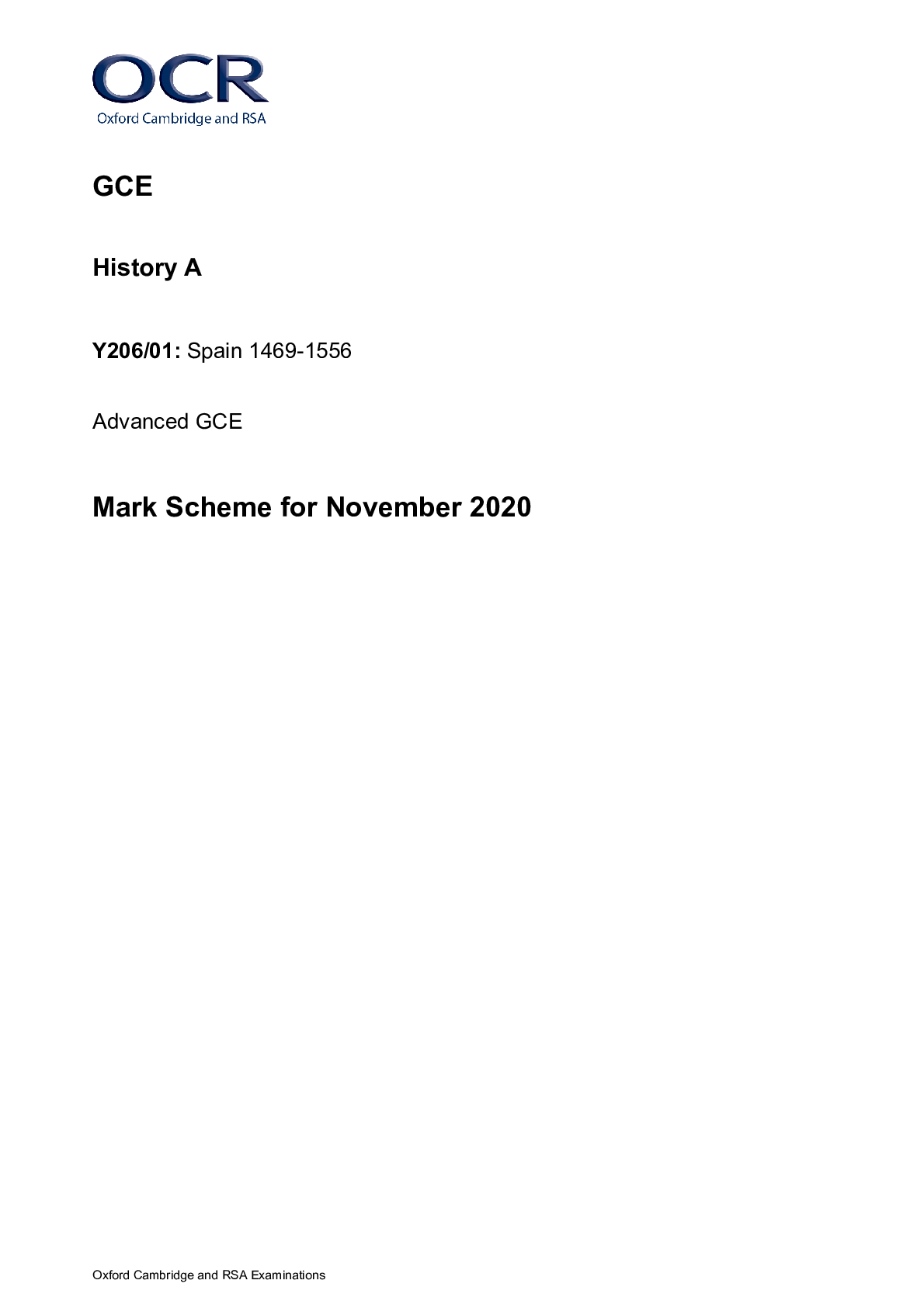
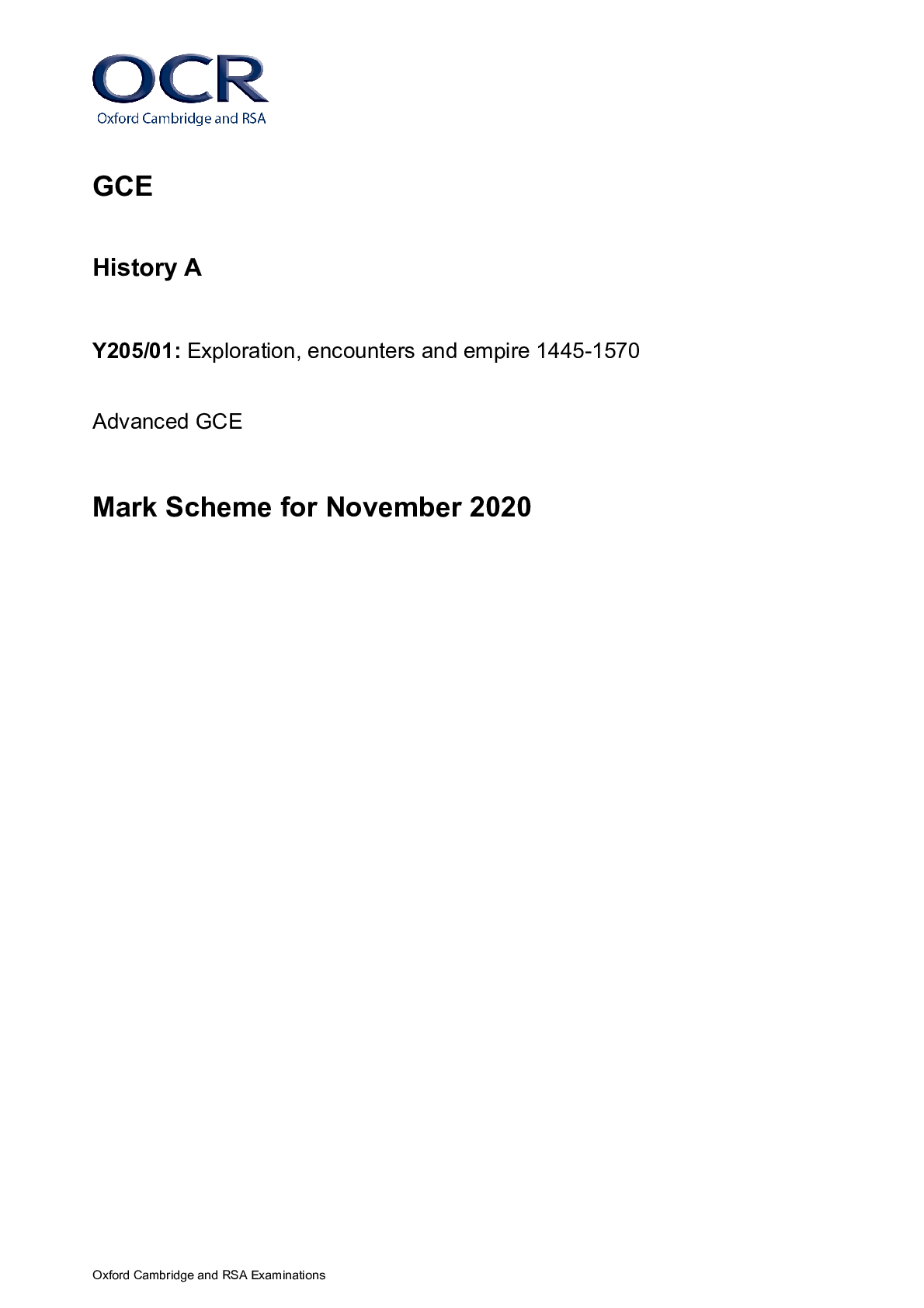






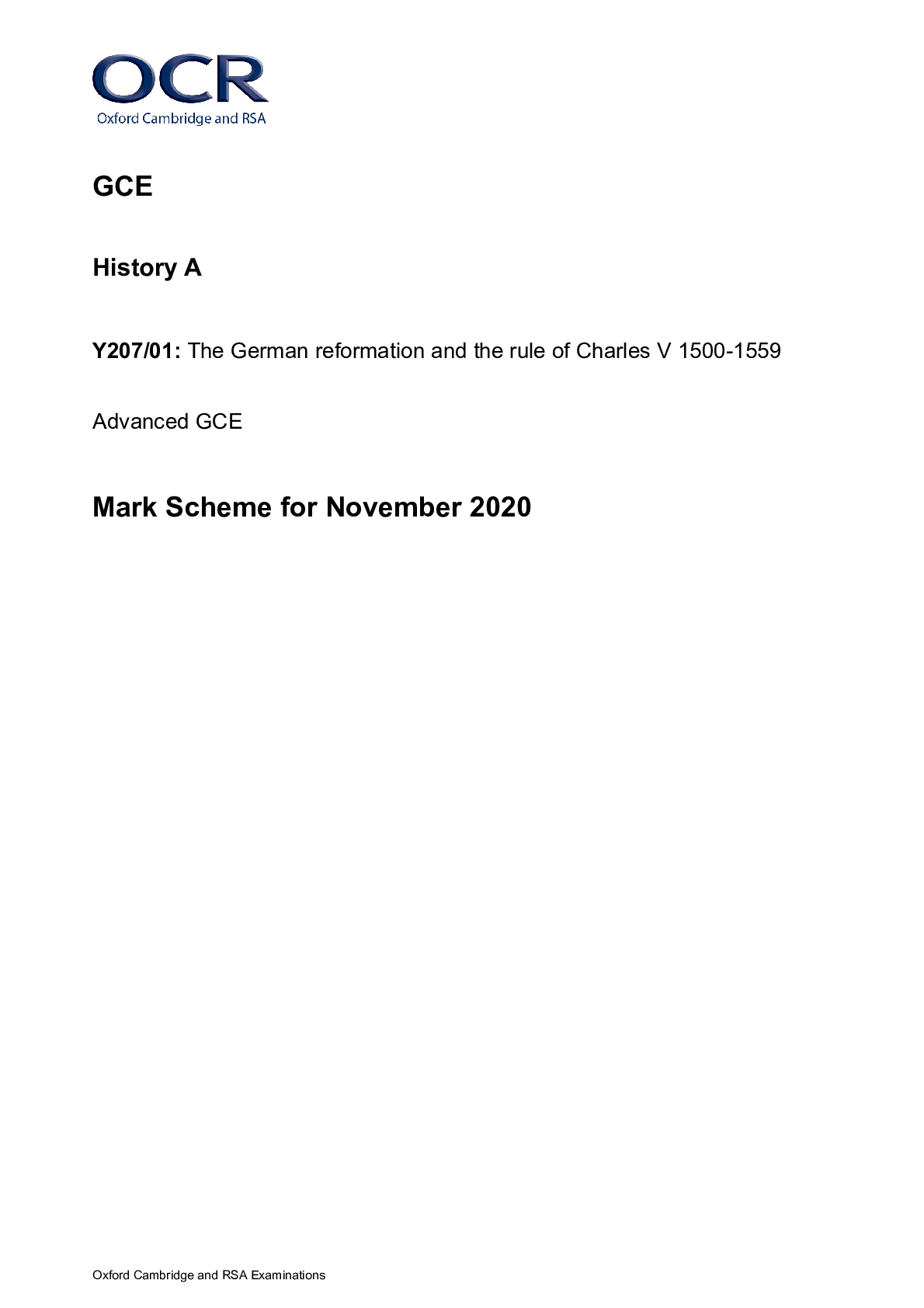






.png)



